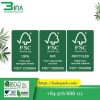Chứng nhận FSC có nghĩa là gì?
Hội đồng quản lý rừng (FSC) chứng nhận rừng để đảm bảo môi trường của họ được quản lý có trách nhiệm và đáp ứng các tiêu chuẩn cao nhất về môi trường và xã hội.
Theo FSC: Rừng được chứng nhận FSC phải được quản lý theo các tiêu chuẩn cao nhất về môi trường, xã hội và kinh tế. Cây được khai thác sẽ được trồng lại hoặc được phép tái sinh tự nhiên. Rừng phải được quản lý với sự tôn trọng thích đáng đối với môi trường, động vật hoang dã và những người sống và làm việc trong rừng. Đây là điều làm cho hệ thống FSC trở nên độc đáo và đảm bảo rằng một khu rừng được quản lý tốt, từ việc bảo vệ quyền của người bản địa đến các phương pháp chặt cây. FSC là chương trình chứng nhận rừng duy nhất được WWF và Woodland Trust chứng thực.
FSC giúp chứng nhận sản phẩm thông qua các giám định viên độc lập và chuỗi lưu ký (CoC). Là một tổ chức chứng nhận toàn cầu, FSC luôn thử nghiệm những cách mới để làm cho hệ thống dán nhãn dễ tiếp cận hơn đối với mọi người và đặc biệt là đối với các nhà bán lẻ toàn cầu có trách nhiệm nhất, đảm bảo họ có thể đạt được sự nhất quán về môi trường trên toàn bộ chuỗi cung ứng của mình.
Phù hợp với điều này, FSC đang làm nhiều hơn là tạo ra và triển khai một khuôn khổ cho sự xuất sắc của rừng. Tổ chức này cũng đang phát triển các tiêu chuẩn quốc gia mới ở những nơi trên thế giới mới áp dụng hệ thống FSC và tìm cách theo dõi việc áp dụng các sản phẩm FSC, gần đây nhất là bằng cách thử nghiệm sử dụng blockchain để theo dõi các giao dịch.
Tại sao chứng nhận FSC lại quan trọng?
Nếu bạn hỏi một người qua đường về FSC cách đây năm năm, khả năng họ nghe nói đến nó là không cao. Giờ đây, người tiêu dùng ngày càng nhận thức được các chứng nhận về môi trường và thường xuyên yêu cầu các công ty chịu trách nhiệm bằng cách chỉ mua hàng từ các nhà cung cấp được chứng nhận.
Những khách hàng có ý thức (bao gồm hầu hết dân số) hiểu được tầm quan trọng của rừng, từ vai trò cung cấp không gian ngoài trời có giá trị đến nơi sinh sống của nhiều người bản địa và động vật. Theo nghĩa khái niệm hơn, rừng là nơi trú ngụ của tất cả chúng ta—là hàng phòng thủ tốt nhất chống lại biến đổi khí hậu. Do đó, người mua sắm trung bình phản đối nạn phá rừng, đam mê bảo vệ các loài quý hiếm và ngay lập tức bị thu hút bởi nhãn hiệu FSC.
Nếu bạn là một thương hiệu toàn cầu trong bối cảnh thương mại ngày nay, nguồn cung được chứng nhận FSC là điều hiển nhiên, với những người tiên phong như thương hiệu quần áo may sẵn Sézane và nhà cung cấp giấy vệ sinh cao cấp Andrex chứng minh rằng nguồn cung toàn cầu các sản phẩm được chứng nhận FSC, dù là thời trang hay các mặt hàng sợi khác, là khả thi.
Các nhà bán lẻ toàn cầu ủng hộ FSC
Chuỗi lưu ký (CoC) của FSC bao gồm hơn 50.000 công ty trên toàn thế giới, bao gồm nhiều công ty dẫn đầu thị trường về thời trang và dệt may.
Gucci, Burberry và thậm chí cả Disney đều cam kết sử dụng vật liệu được chứng nhận. Burberry sử dụng bột giấy nguyên chất được chứng nhận để làm bao bì giấy sang trọng, Gucci sử dụng vật liệu FSC trên tất cả các bao bì và nhãn treo theo kế hoạch phát triển bền vững của họ và Disney cam kết chỉ sử dụng nhãn được chứng nhận FSC trên các sản phẩm mà họ có quyền kiểm soát trực tiếp quá trình sản xuất.
Rõ ràng có bao nhiêu thương hiệu đang bắt đầu sử dụng vật liệu được chứng nhận FSC chỉ bằng cách nhìn vào mức độ nổi bật của nhãn cây ve. Cho dù đó là nhãn hiệu hiển thị nhãn tái chế 100% FSC, phiên bản hỗn hợp hay tùy chọn tái chế.
Cam kết bán hàng hóa được chứng nhận FSC
Cho dù hoạt động của bạn trải dài trên nhiều quốc gia trong cùng một châu lục hay toàn cầu, thì việc chỉ bán hàng hóa được chứng nhận FSC là điều hoàn toàn khả thi.
Trên thực tế, không có bất kỳ nhược điểm rõ ràng nào khi áp dụng FSC hoàn toàn, vì hành trình này có thể đưa bạn đến một chuỗi cung ứng minh bạch hơn. Thay vì phân chia các nhà cung cấp theo khu vực địa lý, một nhà cung cấp quốc gia sẽ giúp sản xuất của bạn đồng đều hơn, chưa kể đến việc thân thiện hơn với môi trường.
Các chuyên gia xây dựng thương hiệu hướng đến tính bền vững có thể giúp bạn điều hướng mạng lưới sản xuất toàn cầu phức tạp ngày nay và ngay lập tức liên kết bạn với các nhà sản xuất địa phương có cùng giá trị.
Nếu bạn vẫn chưa chắc chắn về tất cả các nguồn vật liệu của mình, thì bây giờ là lúc để thay đổi. Hãy nghĩ về chuỗi cung ứng của bạn theo quan điểm bền vững.







